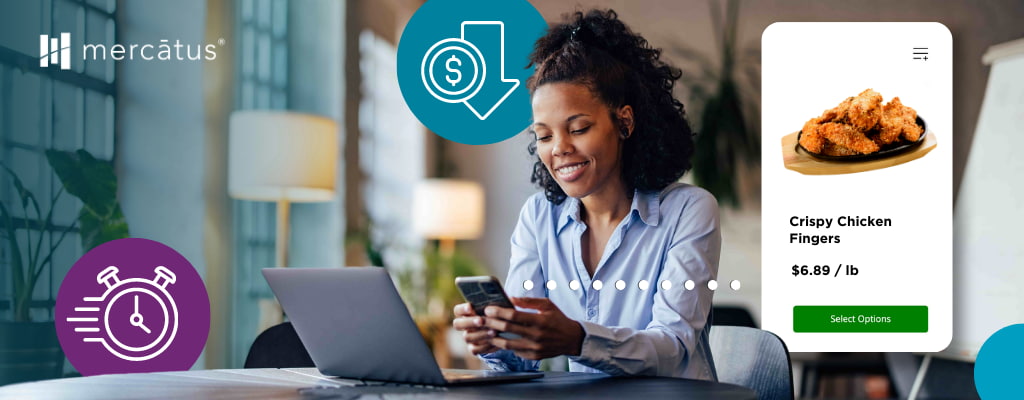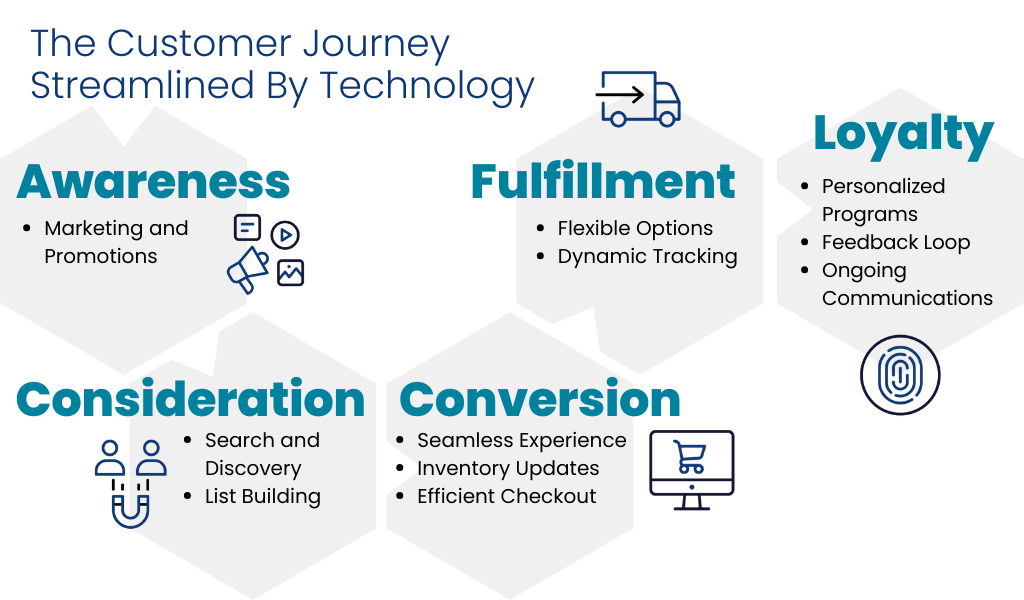Introduction
The growing demand for personalization in retail reflects a shift in how consumers expect to shop today. Retailers are now focusing on offering individualized experiences that cater to specific customer preferences. As competition in the grocery industry continues to become about competing with big players, providing a personalized shopping experience has become a strategic requirement to continue business operations and grow.
Personalization in retail refers to the process of delivering unique shopping experiences to customers based on their behaviors, preferences, and interactions with a brand. This approach aims to improve customer engagement by making the shopping journey more relevant and enjoyable. Customers now expect personalized product recommendations, targeted offers, and customized communication from the brands they interact with.
Several key technologies are driving this transformation. Artificial intelligence (AI) plays a role in helping retailers analyze large sets of customer data to predict shopping patterns and preferences. E-commerce personalization platforms also contribute by enabling retailers to automate the delivery of tailored experiences across digital touchpoints. Together, these technologies allow brands to offer more precise and meaningful interactions, increasing the likelihood of repeat purchases and building stronger relationships with customers.
The Role of Personalization in Retail
Personalization plays a growing role in modern retail by focusing on creating experiences that resonate with individual shoppers based on shopping history. The goal is to make every customer interaction relevant and engaging, which ultimately drives customer engagement and loyalty. Retailers who prioritize personalization in retail strategies can meet the expectations of today’s consumers and position themselves as leaders in the competitive market.

Why Personalization is Key in Modern Retail
In modern retail, customers expect more than just a transaction—they expect meaningful interactions that are tailored to their unique needs. Personalization in retail allows businesses to meet these expectations by using customer data to deliver relevant experiences.
- Boosting Customer Engagement: Personalization helps retailers craft interactions that are relevant to each customer. By analyzing customer data, retailers can offer products and promotions that align with individual interests. When customers feel understood, their engagement with the brand increases.
- Higher Conversion Rates: Personalized product recommendations and offers are more likely to convert because they align with what the customer is already interested in.
- Improving Customer Retention: By consistently offering a personalized shopping experience, retailers can foster long-term relationships with their customers.
Retailers who effectively implement personalization in retail strategies can create deeper connections with their customers. This boosts engagement and leads to higher sales and customer loyalty.
The Impact of Personalized Shopping Experiences
A personalized shopping experience ensures that each interaction feels relevant and meaningful to the individual. When customers receive offers, recommendations, and content that align with their preferences, they are more likely to feel valued by the brand and continue to make purchases. This drives both satisfaction and loyalty, making personalization an essential aspect of customer experience in retail.
- Meeting Individual Needs: Personalization allows retailers to address specific customer preferences, behaviors, and past interactions. This ensures that each customer’s needs are met more effectively than with generic marketing strategies.
- Real-Time Personalization Enhances Shopping Journeys: With the help of real-time personalization, retailers can adjust offers and product recommendations instantly. This ability to provide timely and relevant information makes the shopping journey smoother and more satisfying for the customer.
- Tailored Offers Drive Engagement: Personalized offers that are based on a customer’s purchase history or browsing behavior are far more likely to catch the customer’s attention. By targeting the right audience with the right message, retailers can drive greater engagement and encourage action.
Offering a personalized shopping experience is no longer optional for retailers who wish to stay competitive. Personalization meets customer expectations while enhancing satisfaction and loyalty, ultimately improving the overall shopping journey.
Best Practices for Implementing Personalization in Retail
Implementing personalization in retail requires careful planning and execution to ensure that the experiences offered to customers are meaningful and effective. By adopting best practices, retailers can harness the power of personalization to enhance customer engagement, improve sales, and strengthen brand loyalty.
Collecting and Utilizing Customer Data Effectively
The foundation of personalization in retail lies in the ability to gather and use customer data and behavioral data. These data points allow retailers to understand their customers better and create experiences that are tailored to individual preferences.
- Understanding Customer Preferences: Customer data, including purchase history, browsing behavior, and demographics, helps retailers gain insights into what customers want. By analyzing this data, businesses can create personalized recommendations and offers that align with customer preferences.
- Predictive Analytics for Behavior Forecasting: Predictive analytics combined with AI helps retailers anticipate customer needs. By analyzing past behavior, retailers can forecast future actions, such as what products a customer is likely to purchase next. This enables retailers to deliver personalized content at the right time.
- Using Behavioral Data for Personalization: Behavioral data includes information on how customers interact with a brand online and offline. This data can be used to customize the shopping experience, offering relevant products or content based on past behaviors.
By effectively collecting and utilizing customer data, retailers can deliver highly relevant, personalized experiences that meet customer needs and expectations. Predictive technologies like AI enhance these efforts by forecasting future customer behavior, driving more targeted engagement.
Developing Technology for Personalization Success
Technology is a key enabler of personalization in retail, allowing businesses to scale personalized experiences across their customer base. E-commerce personalization platforms and AI technologies are particularly valuable tools for automating personalization and ensuring consistency.
- Automating Personalization with E-commerce Platforms: E-commerce personalization platforms help retailers automate the delivery of personalized content. These platforms can track customer behavior, segment audiences, and deliver personalized product recommendations and promotions across multiple channels.
- Hyper-Personalization Through AI: Artificial intelligence in retail enables hyper-personalization, where the experience is tailored at a granular level to individual customers. AI can analyze vast amounts of customer data quickly, making real-time decisions about what content or products to show a customer.
- Scaling Personalization Efforts: Technology allows retailers to scale their personalization in retail efforts efficiently. By automating tasks such as personalized email campaigns, recommendations, and ads, businesses can offer consistent experiences to a large customer base without manual effort.
Leveraging e-commerce personalization platforms and AI helps retailers automate and scale their personalization efforts. This ensures that customers receive relevant, personalized experiences in real time, improving engagement and satisfaction.
Creating Omnichannel Personalized Experiences
To provide a seamless personalized shopping experience, retailers must adopt an omnichannel retail approach. This ensures that personalization efforts are consistent across all customer touchpoints, whether in-store or online.
- Seamless Integration Across Channels: Omnichannel retail involves integrating both digital and physical shopping experiences. Customers who browse online and purchase in-store, or vice versa, expect consistent personalization.
- Dynamic Content for Engaging Customers: Retailers can use dynamic content to personalize experiences across different platforms. This includes personalized website content, tailored product recommendations, and custom promotions that adapt to customer preferences and behavior in real time.
- Personalized Promotions Across Platforms: Offering personalized promotions on different channels, such as email, SMS, or social media, helps retailers reach customers where they are most active.
Creating an omnichannel retail experience ensures that personalization efforts are consistent and effective across all platforms. By using dynamic content and personalized promotions, retailers can enhance customer engagement and ensure a seamless shopping journey.
Grocery Personalization: A Growing Trend
Grocery personalization is rapidly becoming a key differentiator in the retail sector, providing a tailored shopping experience that meets individual customer preferences. The implementation of grocery personalization has the potential to increase both customer retention and sales, making it an essential strategy in the modern grocery industry.
How Grocery Personalization Enhances Customer Loyalty
Building customer loyalty allows grocers to stay competitive in a marketplace filled with options. Grocery personalization helps create individualized shopping experiences that encourage repeat purchases and long-term customer relationships.
- Personalized Discounts: By analyzing customer data, grocers can offer discounts on frequently purchased items, enhancing the shopping experience and making customers feel valued.
- Product Recommendations: Grocers can use purchase history to recommend products that align with a customer’s shopping habits. These recommendations can introduce customers to new products they might enjoy, increasing their overall satisfaction.
- Customized Promotions: Tailoring promotions based on shopping behaviors encourages higher engagement.
Grocery personalization enhances customer satisfaction by providing relevant discounts and recommendations, ensuring that customers feel understood and valued. This approach significantly boosts customer loyalty.
Real-Time Personalization in Grocery Shopping
Real-time personalization allows grocers to adjust their marketing strategies dynamically, delivering promotions and product suggestions that align with a customer’s current behavior. This approach helps maintain relevance and increases engagement during the shopping process.
- Timely Promotions: Real-time personalization enables grocers to deliver relevant offers when customers are actively shopping. Sending a promotion for an item a customer frequently buys right before they purchase encourages immediate action.
- Interactive Product Recommendations: Grocers can offer real-time, interactive product recommendations based on the customer’s browsing or purchase behavior.
- Behavior-Driven Discounts: Using customer data to trigger discounts at the right moment ensures the offers feel relevant. Offering a discount on a product a customer regularly purchases when their typical buying cycle ends increases the likelihood of repeat purchases.
Grocery personalization is changing the way customers interact with grocery retailers, creating a more personalized shopping journey that leads to higher customer loyalty and engagement. By implementing real-time personalization and offering tailored discounts and product recommendations, grocers can deliver experiences that resonate with their customers, helping them stand out in a competitive market.
Key Strategies for Retail Personalization Success
Implementing personalization in retail successfully requires a structured approach that aligns with customer expectations. By developing clear strategies, retailers can ensure that personalization efforts meet customer needs and drive engagement, loyalty, and sales. Below are key strategies for building and enhancing personalization in retail.

How to Build an Effective Personalization Strategy
A well-crafted personalization strategy is fundamental to improving the customer experience and boosting business outcomes. Retailers need to focus on gathering the right data, segmenting their audience, and deploying personalized marketing efforts that resonate with individual shoppers.
- Customer Segmentation: Retailers must start by organizing their customers into distinct groups based on demographics, behavior, and purchasing history. Customer segmentation allows businesses to create targeted marketing efforts that are tailored to each segment’s specific needs and preferences.
- Personalized Marketing Campaigns: These campaigns use insights from customer data to deliver targeted ads, emails, and promotions that are relevant to each customer. This increases the likelihood of engagement and conversion.
- Customer Loyalty Programs: Personalized customer loyalty programs are highly effective in encouraging repeat purchases. By offering rewards based on individual shopping habits, retailers can increase customer loyalty and foster long-term relationships with their customers.
Building an effective personalization strategy requires careful planning and strategic use of customer data. By focusing on customer segmentation and personalized marketing, retailers can deliver highly targeted experiences that drive customer loyalty and engagement.
Improving the Customer Journey with Personalization
Personalization should be woven throughout the entire customer journey to create a consistent and meaningful shopping experience. This approach helps retailers build stronger, long-lasting relationships with their customers by addressing their specific needs at every stage.
- Personalized Touchpoints: Personalization can be integrated across various touchpoints, including emails, apps, websites, and physical stores. Whether through personalized product recommendations or targeted promotions, each interaction should reflect the customer’s preferences and shopping history.
- Data-Driven Communication: Personalized communication across all channels is essential for building trust and engagement. Retailers can use customer data to send timely and relevant messages.
- Seamless Integration Across Channels: Ensuring a seamless experience across multiple platforms, whether online or in-store, is key to enhancing the customer journey. By using omnichannel retail strategies, retailers can provide consistent personalization.
Personalization in retail is more than just a trend—it’s a tool for creating deeper connections with customers. By focusing on strategies like customer segmentation, personalized marketing, and seamless communication across touchpoints, retailers can deliver personalized experiences that drive engagement and loyalty throughout the customer journey.
Personalization Challenges and How to Overcome Them
While personalization in retail offers significant advantages, it also presents several challenges that retailers must navigate to ensure successful implementation. Successfully navigating the challenges of personalization in retail requires retailers to address data privacy concerns, manage large datasets effectively, and integrate the right technology.
Common Challenges in Retail Personalization
Retailers face several challenges when implementing personalization strategies. These challenges can hinder the effectiveness of personalization efforts and impact the customer experience if not properly addressed.
- Data Privacy Concerns: With the increasing amount of customer data required for personalization, ensuring data privacy is a major concern. Customers are more aware of how their data is used, and any misuse can lead to a loss of trust and loyalty. Retailers must adhere to data privacy laws and ensure that customer data is handled responsibly.
- Managing Large Datasets: Personalization requires the analysis of vast amounts of customer data. Managing these large datasets can be overwhelming, and without proper systems in place, it’s difficult to extract meaningful insights.
- Integrating Personalization Technology: Implementing the right technology to deliver personalized experiences can be a challenge, particularly for retailers who lack the necessary infrastructure. E-commerce personalization platforms and AI tools can require significant resources and expertise to integrate and manage effectively.
Retailers must address these challenges to ensure that their personalization efforts are successful, ethical, and aligned with customer expectations.
Solutions for Effective Data Management
Overcoming the challenges of personalization requires strong data management strategies. By improving data collection methods and ensuring transparency, retailers can build trust with customers.
- Improving Data Collection Methods: To manage large datasets effectively, retailers need to streamline data collection processes. E-commerce personalization platforms can help by consolidating customer data from online and offline interactions, providing a complete view of the customer’s behavior.
- Ensuring Compliance with Privacy Regulations: Retailers must comply with data privacy laws such as GDPR and CCPA, which govern how customer data is collected, stored, and used. This includes obtaining explicit consent from customers before using their data for personalization efforts.
- Transparency and Building Trust: Retailers should be upfront with customers about how their data is being used to personalize their shopping experience. Providing easy-to-understand privacy policies and giving customers control over their data through opt-in features helps foster long-term loyalty.
By implementing these solutions, retailers can effectively manage customer data and provide personalized experiences while maintaining trust and compliance with privacy regulations.
Future Trends in Retail Personalization
As the retail landscape continues to evolve, personalization is expected to play an even more significant role in shaping the future of customer experiences. Emerging technologies such as artificial intelligence (AI), real-time personalization, and predictive analytics are at the forefront of these changes, allowing retailers to deliver more precise, timely, and individualized interactions.

Emerging Personalization Trends
Retailers are constantly seeking new ways to enhance their personalization efforts, and the following trends are expected to drive the next wave of innovation in the industry.
- Artificial Intelligence for Deeper Personalization: By analyzing vast amounts of customer data, AI can identify patterns and preferences that would be impossible to detect manually. This allows for deeper personalization, such as recommending products based on nuanced customer behaviors and predicting future preferences. As AI technology advances, retailers will be able to deliver even more tailored and relevant experiences.
- Real-Time Personalization in Every Interaction: Real-time personalization is a way for customers to get immediate and relevant responses to their shopping patterns. Whether online or in-store, retailers can use real-time data to adjust recommendations, offers, and content on the fly.
- Predictive Analytics for Anticipating Customer Needs: Predictive analytics uses historical data to anticipate what customers are likely to do next. This allows retailers to proactively offer products, services, or promotions that align with the customer’s future needs. The ability to anticipate and act on customer needs will be a major competitive advantage for retailers.
As AI, real-time personalization, and predictive analytics become more refined, retailers will be able to offer more immersive and individualized customer experiences. Staying ahead of these trends will be essential for retailers who want to maintain a competitive edge and meet the evolving expectations of their customers.
Conclusion
Grocery personalization has become a valuable strategy for businesses aiming to drive customer loyalty and achieve long-term success. By delivering tailored experiences that cater to individual customer needs, retailers can significantly boost engagement, increase sales, and build stronger relationships with their customers.
Whether through AI-driven recommendations, real-time personalization, or leveraging customer data to create relevant offers, personalization ensures that customers feel valued and understood. Those who effectively implement these strategies will meet customer expectations and thrive in the grocery retail environment. Incorporating personalization in retail is no longer a trend but a key strategy for retailers seeking to improve customer engagement and stay competitive.
Frequently Asked Questions (FAQs)
What is personalization in retail?
Personalization in retail involves tailoring the shopping experience to individual customers based on their behaviors, preferences, and interactions with the brand.
How does personalization improve customer experience in retail?
It enhances relevance, making customers feel valued with tailored product recommendations, offers, and communications, which leads to increased satisfaction and loyalty.
What are the best practices for personalization in retail?
Focus on customer segmentation, utilize AI for insights, and deliver personalized content through omnichannel retail strategies.
How can retailers use customer data for personalization?
Retailers analyze customer data like purchase history and browsing patterns to deliver relevant recommendations, discounts, and tailored communications.
How does AI contribute to retail personalization?
AI analyzes vast datasets in real time, predicting customer preferences and automating personalized recommendations and offers.
What are the benefits of omnichannel personalization?
Omnichannel personalization provides a seamless and consistent shopping experience across all touchpoints, increasing engagement and customer loyalty.
How can small businesses implement personalization in retail?
Small businesses can start with basic customer data analysis, offering targeted promotions and personalized product recommendations using cost-effective e-commerce platforms.